Overview
Junipers (Juniperus spp.) are small evergreen trees or bushes that are members of the cypress family. Some species are also referred to as cedars. Junipers are one of the hardiest, most versatile and drought-tolerant shrubs. They are conifers with prickly young foliage that becomes flatter and softer with age.
Characterized by columnar or conical shapes, all junipers are small with most reaching no more than 30 feet high. Some red cedar juniper specimens, however, can grow up to 90 feet. Junipers have short trunks with reddish-brown bark that cracks easily. These evergreens fit into nearly any planting situation by offering a variety of forms.
Leaves are shaped like short needles and are gray-green or blue-green, growing in whorls of three on woody twigs. When crushed, the leaves often smell like lemons or apples. Unlike most trees, junipers are dioecious, meaning that individual plants produce either male or female flowers. Fruit is in the form of small green berries, which turn dark bluish purple when ripe. Each berry contains three to six seeds.
Junipers grow best in full to partial sun locations with good soil drainage. They need around six hours of direct sunlight each day. Growing them in the shade causes the plants to lose their denseness by spreading out while reaching for the sunlight.
This woody plant is widespread in northern Europe, Asia and Japan, Alaska, Canada and Greenland. In the United States, junipers can also be found in the mountainous regions of the Appalachians and in the western states of Utah, California, Arizona and New Mexico.
Varieties of Juniper Trees
1. Alligator Juniper
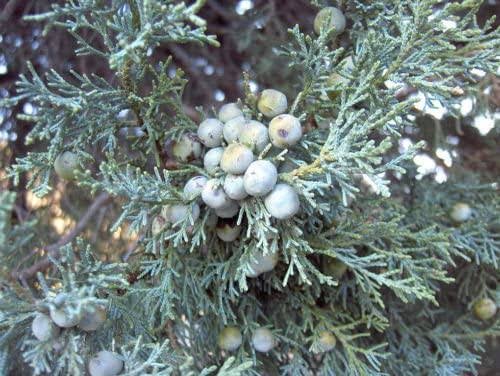
Alligator juniper (Juniperus deppeana) also referred checkerbark juniper is a small to medium-sized coniferous evergreen that gets its name from its distinctive furrowed, scale-like bark. The tree grows about 20 to 40 feet tall in the home landscape, but can reach heights of 65 feet. It forms a broadly-pyramidal or round-topped crown.
The bark is usually very distinctive, unlike other junipers, hard, dark gray-brown, cracked into small square plates superficially resembling alligator skin; it is however sometimes like other junipers, with stringy vertical fissuring.
The leaves are arranged in opposite decussate pairs or whorls of three; the adult leaves are scale-like on lead shoots. The juvenile leaves (on young seedlings only) are usually needle-like. The cones are berry-like and green, maturing orange-brown with a whitish waxy bloom.
Large trees often have a partially dead crown of grotesque appearance with some branches that die and turn light gray instead of falling; other branches die only in a vertical strip and continue to grow on the other side.
Alligator junipers have had practical uses for many centuries and are an important component in the habitat of many different woodland creatures in their native range. The attractive, fragrant wood of the alligator juniper is occasionally milled for lumber and used to make particleboard and furniture, as well as novelty products.
Also Read: Different Types of Evergreen Trees For Landscaping
2. California Juniper

Juniperus californica (California Juniper) is a shrub or small tree reaching 10–26 ft, but rarely up to 10 meters (33 ft) tall. The bark is ashy gray, typically thin, and appears to be “shredded”. The shoots are fairly thick compared to most junipers.
Foliage is bluish gray and scale-like. The leaves are arranged in opposite decussate pairs or whorls of three; the adult leaves are scale-like on lead shoots. The juvenile leaves (on seedlings only) are needle-like whereas the cones are berry-like, blue brown with a whitish waxy bloom, turning reddish brown, and contain a single seed (rarely two or three).The seeds are mature in about 8 or 9 months. The male cones shed their pollen in early spring.
Although California juniper isn’t a particularly tall tree, because of its spreading habit, slow-growth rate, and shrub-like appearance, it’s often used as a hedge or privacy screen. It can also work well in aiding the stabilization of slopes prone to erosion.
California junipers grow not only on dry slopes and high desert, but many other plant communities when given the chance; you can find them in open woodlands, sage scrub, desert chaparral, montane forest, and even Joshua tree woodland.
The berries found on the female trees can be eaten raw or cooked. They have a sweet taste and fibrous texture. Traditionally, they were also dried and ground up to add as flavoring to a variety of dishes or for medicinal purposes.
3. Chinese Juniper

Juniperus chinensis, the Chinese juniper is a slower-growing broadly pyramidal evergreen tree with light green scale-like leaves. It is a dense, evergreen, small tree with a pyramidal habit that typically grows 15–20 feet tall. It features light to medium green, mostly scale-like foliage that is attractive year-round. Mature trees usually continue to bear some juvenile foliage as well as adult, particularly on shaded shoots low in the crown.
This largely species often has dioecious either male and female plants, but some individual plants produce both sexes of flowers. The plant produces Blue-black berry-like seed cones with a whitish waxy bloom, each containing 2 to 4 seeds. The cones mature after about 18 months after pollination. The pollen cones shed their pollen in early spring.
Chinese juniper has many uses in landscaping, including being used as hedges, privacy screens, ground cover, shade trees, and specimen plantings. It’s best not to situate it where you’ll often be brushing against it, as the foliage is rather coarse and prickly. However, because Chinese juniper is tolerant of salt, it can be used near sidewalks, driveways, and roadways. It is also rarely damaged by animals, such as deer.
4. Common Juniper
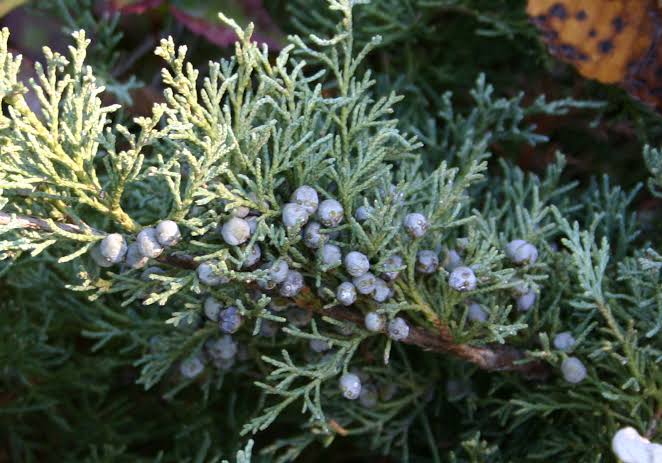
Juniperus communis, the common juniper is very variable in form, ranging from 10 m (33 ft)—rarely 16 m (52 ft)—tall to a low, often prostrate spreading shrub in exposed locations. It has needle-like leaves in whorls of three; the leaves are green, with a single white stomatal band on the inner surface.
It is dioecious, with male and female cones on separate plants, which are wind pollinated. The seed cones are berry-like, green ripening in 18 months to purple-black with a blue waxy coating; they are spherical and usually have three (occasionally six) fused scales, each scale with a single seed.
The seeds are dispersed when birds eat the cones, digesting the fleshy scales and passing the hard seeds in their droppings. The male cones are yellow in color and fall soon after shedding their pollen in March-April.
Common junipers have many different practical uses. In their native regions, the berries are enjoyed by many different species of birds and wildlife and are utilized by humans too. The flavorful berries are a prominent ingredient in gin, and can also be used to make tea and flavor cooked meats and vegetables.
Also Read: Major Types of Maple Trees For Your Yard
5. Creeping Juniper
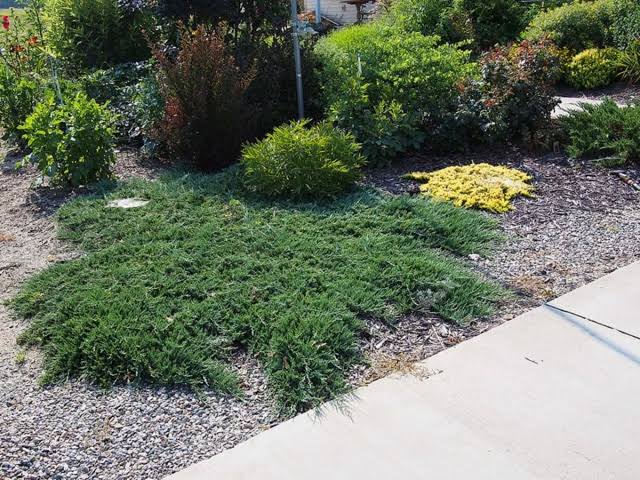
Creeping Juniper (Juniperus horizontalis) is a native low-growing, evergreen shrub that is often used as a ground cover. It features plume-like branches that extend horizontally. The foliage often has a blue-green cast in spring and summer and plum-colored tint in winter. Male and female flowers grow on separate plants, and the female plants produce berries. Neither the flowers nor the berries are particularly ornamental.
It grows up to 1.5 feet high and branches can spread to form a dense mat up to 10 feet wide. The height varies depending on the cultivar. They may be as short as 6 to 8 inches (15 to 20.5 cm.) or as tall as two feet (61 cm.). Each plant can spread as much 6 to 8 feet (2 to 2.5 m.)
It is found growing in rocky or sandy soils from rocky outcrops to streams. It is drought and deer tolerant and moderately salt tolerant. Creeping Juniper is fairly adaptable to soil types and pH as long as the soil is well-drained. Although this plant is native to North America, it is mostly relegated to the Northern United States more sporadically in rocky areas.
These graceful, aromatic shrubs spread to fill sunny areas and they can be used as foundation plants or accents in flower borders. Use them near decks, porches, and garden seating where you can enjoy their pleasant fragrance.
6. Drooping Juniper
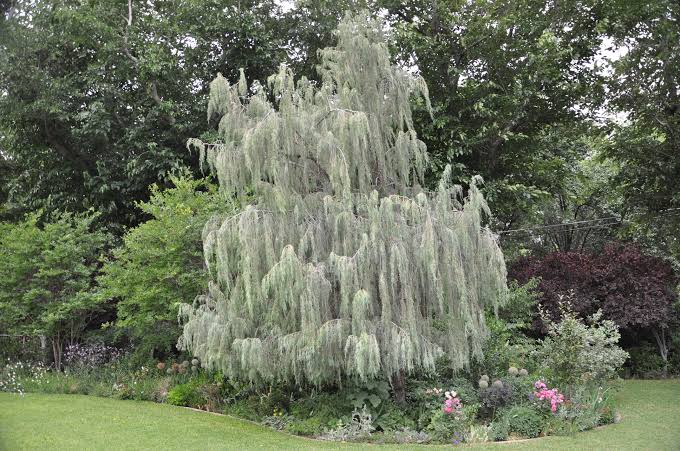
Juniperus flaccida (drooping juniper, weeping juniper or Mexican juniper) is a large shrub or small tree reaching 5–10 m (rarely to 15 m) tall. The bark is brown, with stringy vertical fissuring. The shoots are strongly pendulous, 1-1.2 mm diameter, and often borne in flattened sprays (the only juniper commonly showing this character).
The leaves of drooping Juniper are arranged in opposite decussate pairs; the adult leaves are scale-like on lead shoots. The juvenile leaves (on young seedlings only) are needle-like whereas the cones are berry-like, green in color, maturing to brown, and contain 6-12 seeds (the most seeds per cone of any juniper). The cones are mature in about 18 months. The male cones shed their pollen in spring. It is largely dioecious, producing cones of only one sex on each tree.
The fleshy, berry-like seed cones are edible raw or cooked, and they were used in traditional medicine in past times. Amongst other qualities, they have been shown to have specific anti-fungal and anti-microbial properties.
7. Eastern Red Cedar
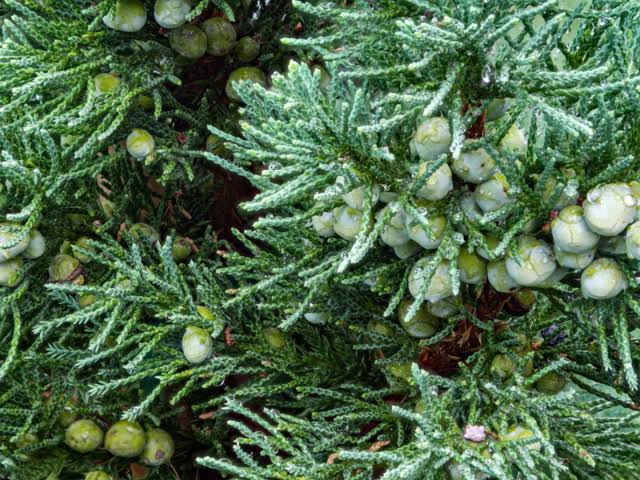
Juniperus virginiana, also known as red cedar, eastern red cedar, Virginian juniper, eastern juniper or red juniper. The trees are shaped like a pyramid or column with grayish to reddish-brown bark. The foliage is blue-green to green and needlelike. Female and male cones are borne on separate trees.
Eastern Red cedar is easily grown in average, dry to moist, well-drained soils in full sun. It will tolerate a wide range of soils and growing conditions, from swamps to dry rocky glades. It can even grow on seemingly barren soils that few other plants can tolerate. It prefers moist soils but is intolerant of constantly wet soils. It only tolerates the shade when it is extremely young.
Red cedars can often be found in cemeteries as ornamentals. The wood is used for furniture, paneling, fence posts, and novelties. Both the fruit and tender young branches contain oil that is used in medicines.
Eastern red cedar twigs and foliage are eaten by browsers while the fruit is eaten most extensively by cedar waxwings. Evergreen foliage provides nesting and roosting cover for sparrows, robins, mockingbirds, juncos and warblers.
Also Read: Major Types of Cypress Trees For Landscaping
8. Greek Juniper
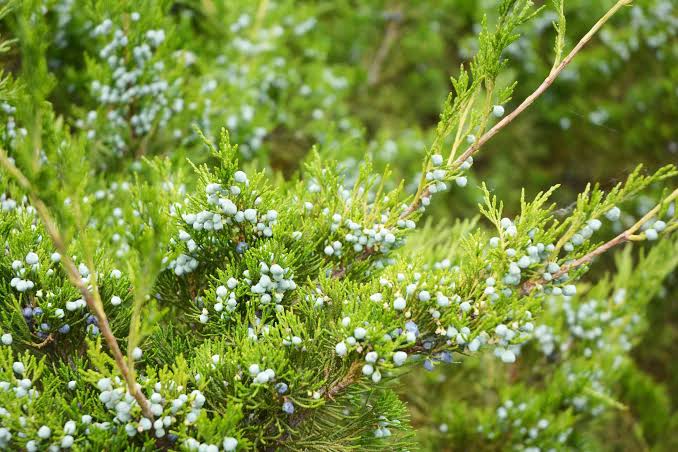
Greek juniper (Juniperus excelsa) is an evergreen and slow-growing tree that can reach up to 20 meters in height, although typically it remains considerably shorter. It has a trunk up to 2 m (6.6 ft) in diameter, and a broadly conical to rounded or irregular crown. The leaves are of two forms, juvenile needle-like leaves 8-10 mm long on seedlings, and adult scale-leaves 0.6-3 mm long on older plants.
It is largely dioecious with separate male and female plants, but some individual plants produce both sexes. The cones are berry-like, Blue-black with a whitish waxy bloom, and contain 3-6 seeds; which mature in about 18 months. The male cones are 3-4 mm long, and shed their pollen in early spring.
Greek juniper has a variety of practical uses. The bark can be used for roofing, and the high-quality wood is used for building purposes and as fuel. The branches also have a pleasing pine scent. They’re sometimes burned as incense and are often added to Christmas wreaths and arrangements.
9. One-Seed Juniper
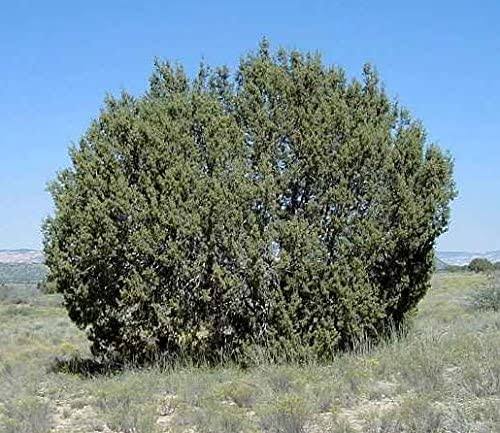
One-seed Juniper (Juniperus monosperma) is a small tree growing to between 6 and 20 feet (rarely to 36 feet) tall, usually multistemmed, and with a dense, rounded crown. The bark is gray-brown, exfoliating in thin longitudinal strips, exposing bright orange brown underneath. The ultimate shoots are 1.2–1.9 mm thick. The canopy is dense, and it regularly becomes home to birds seeking shelter.
The leaves are scale-like on both small and vigorous shoots. The leaves are arranged in alternating whorls of three or opposite pairs. The juvenile leaves, produced on young seedlings only, are needle-like whereas cones are berry-like, with soft resinous flesh and dark blue in color with a pale blue-white waxy bloom; and contain a single seed (rarely two or three). The seed cones mature in about 6–8 months from pollination, and are eaten by birds and mammals.
Young plants are often confused with other plants since they have needles instead of the scaled foliage typical of the mature One Seed Juniper. The plant is effectively adapted to surviving in arid and semi-arid environments. It can stop its growth when not enough moisture is available and begin growing again when it is once again available.
10. Rocky Mountain Juniper
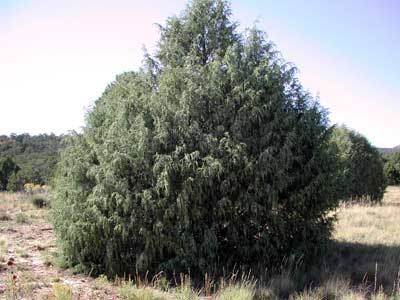
Juniperus scopulorum, the Rocky Mountain juniper occurs throughout the drier mountains and foothills of British Columbia and Alberta; south through the Great Basin and Rocky Mountains to Arizona. It is adaptable to various soil types on the dry side but doesn’t do well in humidity and high nighttime temperatures.
It reaches mature heights of 30 to 40 feet in a columnar shape with one or two main leaders or main “stems”. The foliage depends on the variety but ranges from dark green to blue-green. The needles on young plants are soft and short but become appressed and scale-like as the tree matures.The little fleshy cones ripen in their second year, are dark blue, covered in a whitish bloom, and have been used for food, medicine, and making all types of beverages from tea to gin.
11. Utah Juniper
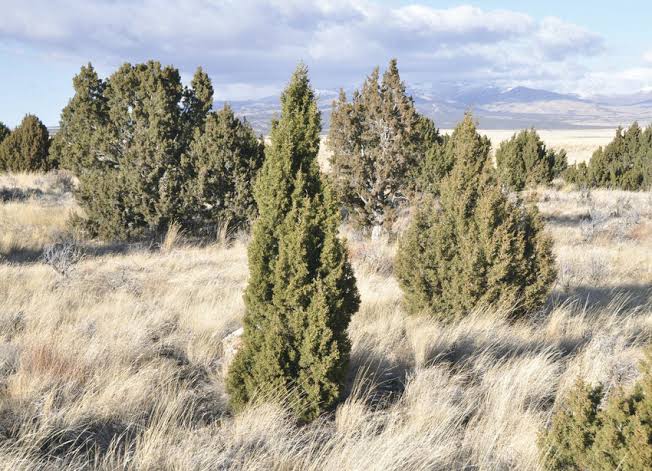
Utah Juniper (Uniperus osteosperma) is a shrub or small tree reaching 3–6 m (rarely to 9 m) tall. It is largely dioecious with both sexes on the same plant, but around 10% of plants are monoecious, producing cones of only one sex.
The leaves are arranged in opposite decussate pairs or whorls of three; the adult leaves are scale-like while juvenile leaves (on young seedlings only) are needle-like. The cones are berry-like, with soft resinous flesh and dark blue in color with a pale blue-white waxy bloom; and contain a single seed (rarely two or three).
The fleshy, berry-like seed cones are edible raw or cooked, and they were used in traditional medicine in past times. Amongst other qualities, they have been shown to have specific anti-fungal and anti-microbial properties.
Utah Juniper is native to the southwestern United States, in Utah, Nevada, Arizona, western New Mexico, western Colorado, Wyoming, southern Montana, southern Idaho and eastern California.
Also Read: Different Types of Oak Trees For Your Garden
12. Western Juniper
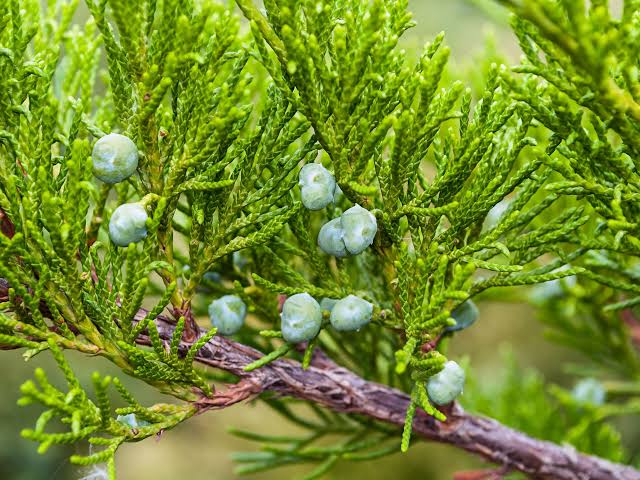
Juniperus occidentalis, known as the western juniper, is a species of Juniper which grows to an average of 50 feet with exceptional trees growing to heights as tall as 80 feet. Western juniper grows best in full sun and well-draining, slightly acidic soil, but it will tolerate a wide range of soil conditions.
The leaves are arranged in opposite decussate pairs or whorls of three; the adult leaves are scale-like, on lead shoots. The juvenile leaves (on young seedlings only) are needle-like whereas he cones are berry-like, blue-brown in color with a whitish waxy bloom, and contain one to three seeds; they are mature in about 18 months. The male cones are 2–4 mm long, and shed their pollen in early spring.
The cones on female western junipers are often mistaken for berries. They have blue fleshy pulp that is often covered in a white bloom. These cones are eaten by wildlife of all sorts, but, if they survive to ripen after two years, they will release their seeds.
Besides providing a meal for the native fauna, the cones, leaves and wood of the western juniper have many uses in medicinal, ritual, craft, and culinary arts, and have been used for these purposes for thousands of years.
13. Foetid Juniper or Stinking juniper

Juniperus foetidissima, with common names foetid juniper or stinking juniper is a medium-sized tree reaching between 20 and 82 ft tall, with trunks of up to 8.2 ft diameter. It has a broadly conical to rounded or irregular crown. It is native to southeastern Europe and Western Asia, from southern Albania and northern Greece, southern North Macedonia, across Turkey to Syria and the Lebanon.
The leaves are of two forms, juvenile needle-like leaves on seedlings and re-growth after branch damage, and adult scale-leaves on older plants. It is largely dioecious with separate male and female plants, but some individual plants are monoecious, producing both sexes. The cones are berry-like, blue-black in color with a whitish waxy bloom, and contain 1-2 (rarely 3) seeds; they are mature in about 18 months. The male cones shed their pollen in early spring.
Further References
- Facts About Juniper: https://en.m.wikipedia.org/wiki/Juniper
- Major Types of Juniper Trees: https://conifersociety.org/conifers/articles/types-of-juniper-trees/
- Juniper Trees: https://www.britannica.com/plant/juniper
- Varieties of Juniper Trees: https://www.gardeningknowhow.com/ornamental/shrubs/juniper/growing-juniper-trees.htm
- Juniper Trees: https://hgic.clemson.edu/factsheet/juniper/